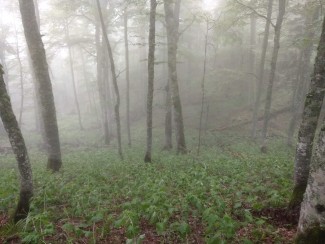List of locations
Bosnia
Bosnia and Herzegovina is a predominantly mountainous country situated in the northwestern region of the Balkan Peninsula. Due to the danger of soil erosion on steep slopes, the transformation of primary forests in this country was mostly conducted gradually by applying single-tree selection silviculture. For this reason also, there are still many protected forests with diverse level of protection. Virgin forest reserves cover an area of 2,004 ha, or 0.07 % of the total forested area of the country.1 The largest and well-known virgin forests in the country are Perućica (1,434 ha), Lom (295 ha), and Janj (228 ha); all the forests are situated approximately 90 km from the Adriatic coast. These primary forests are composed mostly of European beech (Fagus sylvatica L.), silver fir (Abies alba Mill.), and Norway spruce (Picea abies (L.) H. Karst.)2, while other tree species, such as sycamore maple (Acer pseudoplatanus L.), Wych elm (Ulmus glabra Huds.) and European ash (Fraxinus excelsior L.) are present as minor components of the stands. Bosnian old-growth forests are predominantly characterized by small-gap dynamics 3, 4; they have very high wood volumes that exceed 1,000 m3·ha-1 in some places 5, and deadwood volumes are also very high, often ranging between 327–406 m3·ha-1 6, 7. These primary forests have not experienced chronic overbrowsing by deer and environmental pollution has also been less acute compared to most other European old-growth forests.
For this project we focused on the Perućica primary forest located in the Sutjeska National Park (17,250 ha). The forest is within altitudes ranging from 500 to 2,387 m, with a mean annual air temperature between 5.9 and 8.6 °C and mean annual precipitation ranging from 1,400 to 1,900 mm (Suha and Cemerno stations at 690 and 1,329 m a.s.l., respectively). Sutjeska is the oldest national park in Bosnia and Herzegovina; it was officially established in 1962, but Perućica has been officially protected since 1954. Moreover, nature protection in the area of this primary forest dates back to 1893, and it harbors some of the country’s most valuable natural assets 8. With the great diversity of geological, hydrological, and climatic features, Perućica represents a biodiversity hotspot representative of the entire Dinaric range. Most of the reserve is covered by primary beech-fir forests between 1,000 and 1,600 m a.s.l., however, there are more than 20 different forest associations in the region that range from Carpinetum orientalis to Pinetum mughi. In 2017 Perućica was finally added to the list of World Heritage Sites (UNESCO).
Two smaller primary forests of great interest are Janj and Lom, which have strictly protected core areas of 57.2 and 55.8 ha in size, respectively.5 These primary forests are classified as Piceo-Abieti-Fagetum dynaricum plant associations. Like Perućica, they have been officially protected since 1954, although it is generally believed that even before the official protection, the primary forests in Bosnia and Herzegovina were not exposed to logging activities. These primary forests have remained undisturbed by human activities to the present day due to strict protections, but also the fact that they are remote and forest roads are in rather poor condition, which has helped to preserve their value. The original purpose of strictly protected reserves in this country was to serve primarily as areas for scientific research, but also partly for ecotourism opportunities, such as NP Sutjeska.
| # | Location | Name | |
|---|---|---|---|
| 1. | Sutjeska |  | Perućica |